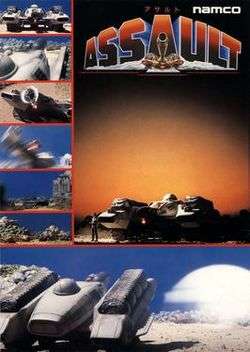Assault (1988 video game)
| Assault | |
|---|---|
|
Arcade flyer | |
| Developer(s) | Namco |
| Publisher(s) |
‹See Tfd› |
| Designer(s) | Kunio Ogawara |
| Composer(s) |
Shinji Hosoe Kazuo Noguchi |
| Platform(s) | Arcade |
| Release date(s) |
Arcade‹See Tfd› Playstation(Namco Museum Volume 4)‹See Tfd› Wii Virtual Console‹See Tfd›
|
| Genre(s) | Multi-directional shooter |
| Mode(s) | Single player |
| Cabinet | Standard upright |
| Arcade system | Namco System 2 |
| CPU |
2x Motorola 68000 @ 12.288 MHz, 1x Motorola M6809 @ 3.072 MHz, 1x Hitachi HD63705 @ 2.048 MHz |
| Sound |
1x Yamaha YM2151 @ 3.57958 MHz, 1x C140 @ 21.39 kHz |
| Display | Vertical orientation, raster, 224 x 288 resolution |
Assault (アサルト Asaruto) is a multi-directional shooter arcade game released by Namco in 1988 and licensed to Atari Games for US manufacture and distribution. It is the last Namco game that was licensed to Atari, even though their logo still appears on the Mejā Stadium scoreboard in World Stadium '89 Kaimakuban and '90.
What makes Assault unique is that the player's tank always points toward the top of the screen, and when the tank turns the entire playfield rotates around the tank. It can be interpreted as rotating the world rather than the tank. Assault made early use of hardware sprite scaling (preceded by at least Sega's Space Harrier in 1985) and may be the first game to use hardware rotation of sprites and the background.
Description
The player controls a futuristic tank, attacking the surface forces of an alien environment. The tank is controlled by two four-way joysticks. The standard movements, such as "forward" and "turn left", are executed in the same manner as those of other tank driving games, like Battlezone. That is, the player pushes both joysticks away for "forward", pull the left joystick towards and push the right one away for "turn left" and opposite for "turn right". But since the joysticks are four-way, two other moves are available. Pushing both joysticks away from one another (i.e. the left to the left and the right to the right) causes the tank to rear up on its back end for a moment. When in this position, the player can fire a lethal nuclear blast, instead of the standard shots, fired in the normal position. Afterwards, the tank returns to its regular mode. If both joysticks are pushed right or left, the tank will roll (or "strafe") in the chosen direction. There are special "power" platforms encountered throughout the game. When the tank is driven unto the platform, it is catapulted into the air and the battlefield is seen from a higher vantage point, and therefore more of the map is also shown. This allows the player to target and shoot at enemy forces from the air, including some that could not be seen in the regular and smaller frame.
One additional innovation is the way the tank enters and exits the battlefield. The tank is airdropped from above. But instead of the tank falling down from the sky, the battlefield appeared to come up towards the tank. When a stage was cleared, the tank would raise above the surface and then drop through a hatch in the ground. These methods of entering and leaving the levels, reinforce the player-tank-centric approach of the game.
The player battles eleven waves of enemy forces (if its "SELECT" setting is set to "ON", the player can begin on Stage 6). After the final stage, the player is rewarded with a list of schematics of his or her tank (much like the ending for Namco's own Blazer), and a final screen saying "Thanks for your play".
Assault Plus
Assault was followed by Assault Plus, an upgraded version with redesigned visuals and color palettes, and adding higher-ranked enemies to earlier stages; instead of a linear run through all 11 stages as in original Assault, the game is presented in episodic format, with each episode titled "Rehearsal for the Core" and "Battle for the Core" respectively. Rehearsal takes place in Stages 1, 3, 4, 5, and the first area of Stage 1 - and Battle contains all the stages except for Stage 1. Assault Plus was not given a release outside Japan; however, it was included as a bonus game in Namco Museum Volume 4 for the Sony PlayStation through a button combination of Up, Triangle, L1, R1 in the "X-Room".
External links
- Assault at the Killer List of Videogames
- Assault Plus at the Killer List of Videogames
- Assault at the Arcade History database
- Assault Plus at the Arcade History database
- Detailed Assault information
